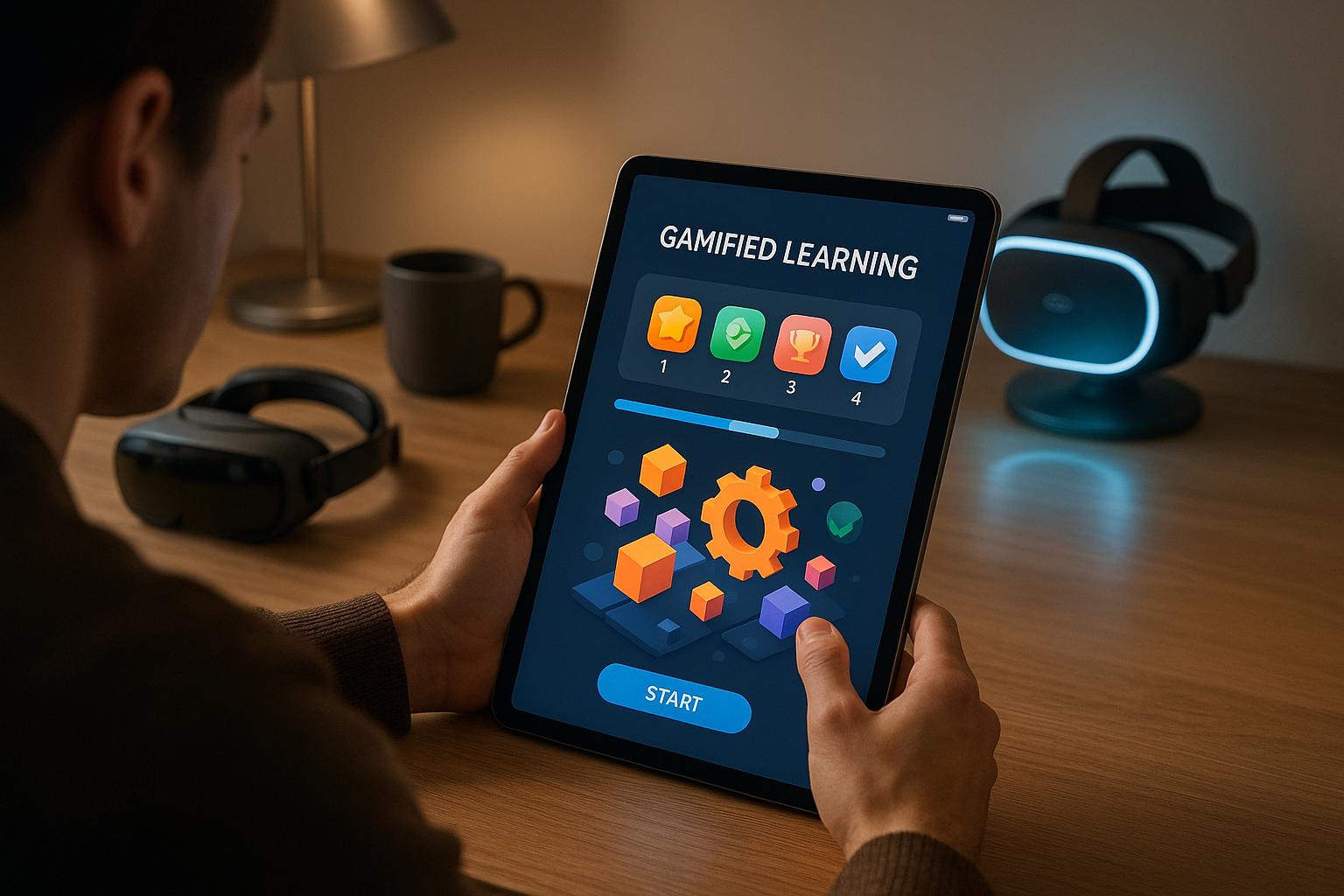AI-driven gamification combines artificial intelligence with game mechanics to create personalised, interactive learning experiences. It replaces traditional, one-size-fits-all approaches with systems that adjust in real-time based on individual performance. This makes learning more engaging, reduces anxiety, and improves outcomes by tailoring content, feedback, and challenges to each learner.
Key highlights:
- Engagement through game mechanics: Points, badges, leaderboards, and progress tracking make learning feel rewarding.
- AI personalisation: Adjusts difficulty, content format, and feedback to suit individual needs.
- Immersive tools: Virtual and augmented reality enhance hands-on practice and collaboration.
- Skill testing: Real-time analytics and adaptive testing offer precise insights into strengths and areas for improvement.
- Accessibility: AI supports diverse learning styles, languages, and abilities while addressing potential barriers like cost and infrastructure.
Platforms like Testudy.io exemplify how AI-powered tools can simplify studying by turning any text into quizzes and flashcards. By learning from user behaviour, these tools become smarter over time, offering tailored support and fostering collaboration.
AI-driven gamification is reshaping education by making learning more interactive, effective, and inclusive, while addressing challenges like teacher training, data privacy, and accessibility.
Key Features of AI-Driven Gamified Systems
Core Game Mechanics
Core game mechanics make learning more engaging by tapping into psychological triggers that encourage learners to keep going. These elements are designed to motivate, reward, and guide learners through their educational journey.
Points and scoring systems provide instant feedback, letting learners see their progress with every correct answer or milestone achieved. This steady stream of reinforcement fosters a sense of accomplishment and keeps learners motivated.
Badges and achievements mark specific milestones, offering recognition for standout moments like mastering a topic, completing a tough quiz, or maintaining a streak of consistent effort. Unlike points, which accumulate continuously, badges serve as clear symbols of success, often becoming a source of pride when shared with peers or displayed on profiles.
Leaderboards add a layer of competition that can energise learners. Seeing their name climb the rankings taps into natural competitive instincts. However, the best systems balance this competitive edge with opportunities for collaboration, ensuring that leaderboards inspire rather than discourage those who may be struggling.
Progress tracking turns abstract learning goals into something tangible. Progress bars, completion percentages, and visual learning paths help learners see where they are and what lies ahead. This clarity reduces uncertainty and helps them set achievable goals for each session.
Striking the right balance between reward frequency and timing is key. Overloading learners with rewards can dilute their impact, while too few can make the effort feel unappreciated. Effective systems carefully adjust these mechanics based on individual preferences and behaviour, laying the groundwork for AI to personalise the experience further.
AI-Powered Personalisation
Artificial intelligence takes these game mechanics to the next level by creating tailored experiences that adapt to each learner’s needs and preferences. This goes well beyond just tweaking difficulty levels – it’s about understanding how every individual learns best.
Adaptive difficulty ensures that learners are always challenged at the right level. If someone is excelling, the AI increases the complexity of tasks. If they’re struggling, it steps in with extra practice, breaking down concepts into smaller, easier-to-digest pieces.
Customised content presentation means learners receive information in formats that suit their style. Some might prefer visuals, others text, and some may thrive with interactive elements. AI observes these preferences and adjusts future content delivery to align with what works best for each person.
Personalised feedback systems go deeper than a simple "right" or "wrong." AI identifies specific errors, explains them clearly, and suggests resources to help learners improve. This targeted guidance not only clarifies mistakes but also builds confidence by showing learners exactly how to get better.
Learning path optimisation creates unique educational journeys for each individual. AI pinpoints strengths and gaps, tailoring the curriculum to ensure learners focus on what they need most. For some, this might mean revisiting foundational concepts, while others can move ahead to advanced topics without delay.
As AI systems gather more data, they refine their personalisation capabilities, making the learning experience feel less like standard software and more like having a personal tutor who understands how you think and learn.
VR and AR Integration
Virtual and augmented reality are redefining gamified learning by delivering immersive experiences that go far beyond traditional methods. These technologies shine in situations where hands-on practice is essential but difficult to achieve in the real world.
Virtual reality environments provide safe spaces for learners to practise complex skills without real-world risks. Whether it’s medical procedures, engineering tasks, or language practice, VR offers realistic scenarios that are both engaging and repeatable, helping learners build confidence and competence.
Augmented reality overlays merge the digital and physical worlds, creating hybrid learning experiences. With AR, learners can use their devices to interact with objects in their environment, access additional information, or solve challenges that blend the real and virtual. This makes learning feel more interactive and relevant.
Spatial learning opportunities take advantage of our ability to better remember information tied to locations and movements. By placing knowledge in three-dimensional spaces, VR and AR create memorable experiences that often lead to better retention compared to traditional screen-based methods.
Collaborative virtual spaces allow learners to connect and work together in shared digital environments, no matter where they are. These spaces can host group projects, peer tutoring, or even competitive challenges, offering a more engaging alternative to standard video calls or text-based collaboration tools.
When combined with AI, VR and AR become even more powerful. AI can adjust virtual environments in real-time based on a learner’s performance, customise AR overlays to highlight relevant details, or tweak the behaviour of virtual characters to provide just the right amount of challenge and support.
For these technologies to truly enhance learning, they need to be both accessible and practical. The best implementations focus on areas where immersive tools clearly outperform traditional methods, rather than using them simply for their novelty.
Impact on Learning Outcomes and Skill Testing
Improved Learning Outcomes
AI-powered gamification is transforming education by blending game mechanics with personalised learning, leading to better retention, critical thinking, and motivation.
Knowledge retention improves significantly when learners engage with gamified systems. Interactive, multi-sensory elements help embed information more effectively than passive learning methods. By using AI to adjust the timing and format of content reviews based on learners’ unique forgetting patterns, knowledge is retained for longer, avoiding the typical sharp decline seen with traditional study techniques.
Critical thinking thrives in these environments, as learners encounter scenarios that push them to analyse, evaluate, and solve problems rather than merely memorising facts. AI ensures challenges grow in complexity, building on prior knowledge and sharpening skills that extend beyond the classroom.
Motivation and engagement remain consistently high because learners feel a sense of progress and control. Gamified systems provide instant feedback, satisfying the need to feel competent, while AI personalisation keeps challenges in the "sweet spot" – neither too easy nor too difficult. This balance keeps learners interested without leading to frustration.
The social dimension of gamified learning also plays a key role. Sharing achievements, collaborating on tasks, or engaging in friendly competition helps learners improve communication skills and benefit from peer support. AI enhances these interactions by pairing learners with complementary strengths or common interests, fostering natural support networks that enrich the experience.
These advancements in learning outcomes pave the way for smarter, more dynamic skill assessments powered by AI.
AI Analytics for Skill Testing
AI analytics revolutionise skill testing by moving away from static exams to a more dynamic, continuous evaluation process. This approach offers a clearer picture of learners’ strengths and areas for improvement, allowing for timely intervention before gaps become major hurdles.
Real-time assessments and predictive analytics highlight weaknesses and anticipate future difficulties. Every interaction – whether it’s the speed of answering questions or patterns in mistakes – provides valuable insights into a learner’s understanding. By analysing this data, AI can notify educators or propose targeted support to address issues early.
Competency mapping provides a detailed view of each learner’s abilities across various skill areas. AI tracks mastery of specific concepts, identifies gaps in prerequisite knowledge, and suggests the best learning paths. This level of insight enables learners to focus their efforts where they’ll see the most benefit.
Adaptive testing algorithms tailor questions based on a learner’s previous answers, making assessments both more efficient and accurate. Instead of administering the same test to everyone, AI adjusts the difficulty dynamically, reducing fatigue while providing precise measurements of ability.
With long-term tracking, AI reveals how learners acquire and retain knowledge over time. This data helps refine teaching strategies and identify what methods work best for different types of learners, providing educators with actionable insights.
Beyond improving accuracy, these tools promote fairness and inclusivity in education.
Supporting Equity and Inclusivity
AI-driven gamification is breaking down barriers in education by adapting to the diverse needs of learners, creating more inclusive and accessible experiences.
Tailoring content to individual preferences ensures that all learning styles are accommodated. AI can determine the most effective presentation methods for each learner and adjust future content accordingly, ensuring no one is penalised for processing information differently.
Language and cultural adaptation allows AI systems to cater to learners from various backgrounds. By adjusting vocabulary and context to align with different cultural norms, these systems create a learning environment where everyone feels valued and understood.
Accessibility features powered by AI provide alternative formats for learners with disabilities. Tools like text-to-speech, visual descriptions, and simplified navigation make learning opportunities accessible to everyone. AI can even remember individual preferences, ensuring a seamless experience across all interactions.
Economic barriers are addressed by optimising resources and identifying low-cost or free alternatives tailored to each learner’s needs. This approach ensures financial limitations don’t stand in the way of educational progress.
Finally, bias detection and mitigation is an area where AI is making strides. By analysing assessment patterns across demographics, AI can identify and correct biases in content or methods, ensuring fair treatment for all learners. This ongoing refinement helps create a more equitable learning environment for everyone.
Challenges and Solutions in Implementation
Key Challenges
AI-driven gamification offers immense potential, but putting it into practice comes with its own set of hurdles. Recognising these challenges is key to ensuring its effective and sustainable use in education.
One major issue is the over-reliance on extrinsic rewards. While badges, points, and leaderboards can boost engagement, they might lead learners to focus too much on external motivators, undermining their natural curiosity and drive to learn.
Another significant barrier is the technical complexity and infrastructure demands. Many schools, especially those with tight budgets, struggle to provide the robust IT systems and reliable internet connections that AI-powered tools require.
Teacher training and digital literacy gaps also present challenges. Without adequate support, educators may feel unprepared or overwhelmed when trying to integrate new AI tools into their teaching.
Data privacy and security concerns are becoming more pressing as AI systems collect and process sensitive student information. Schools must navigate compliance with regulations while safeguarding data against breaches or misuse.
Finally, accessibility and inclusivity challenges can arise. Not all gamification designs work equally well for students with diverse needs, abilities, or backgrounds. Poorly designed systems risk alienating learners rather than engaging them.
Addressing these obstacles is crucial to fully realise the benefits of AI-driven gamification in education.
Strategies for Overcoming Challenges
Tackling these challenges requires thoughtful and targeted strategies.
To avoid over-reliance on external rewards, student-centred design principles are essential. These focus on creating meaningful learning experiences by celebrating progress, mastery, and personal growth. Incorporating choice and autonomy into the process helps maintain intrinsic motivation while still benefiting from gamification.
Phased implementation approaches can help schools gradually enhance their technical capabilities. Starting with basic gamification features and slowly introducing AI-driven personalisation allows time for system upgrades and staff training. This step-by-step method also helps identify and resolve technical issues early.
Addressing teacher training gaps involves ongoing professional development. Hands-on workshops, peer mentoring, and regular follow-up sessions can build educators’ confidence in using new tools. Communities of practice, where teachers share experiences and solve problems together, have proven highly effective.
For data privacy concerns, robust data governance frameworks are critical. These include clear policies on data collection and usage, strong encryption protocols, regular security audits, and transparent communication with students and parents about how their data is used.
Universal design principles ensure gamification systems are inclusive from the start. This means offering multiple ways to engage with content, providing alternative formats for diverse needs, and customising interface elements for individual users. Regular testing with a variety of learners can help identify and address any accessibility issues.
Comparison Table: Pros and Cons
The table below highlights the key benefits and potential drawbacks of AI-driven gamification.
| Aspect | Advantages | Disadvantages |
|---|---|---|
| Engagement | Boosts motivation and keeps learners interested | Can lead to over-dependence on external rewards, reducing intrinsic motivation |
| Personalisation | Adjusts content and difficulty to individual needs | Requires significant data collection, raising privacy and security concerns |
| Scalability | Offers personalised experiences to large groups | Demands high initial investment in technology and ongoing maintenance |
| Assessment | Provides real-time feedback and detailed learning insights | Complex algorithms may be hard for educators to interpret |
| Accessibility | Adapts to various learning styles and abilities | May unintentionally exclude learners who don’t engage with gamification |
| Efficiency | Reduces administrative tasks for educators | Requires substantial teacher training and continuous professional development |
| Innovation | Keeps educational practices engaging and up to date | Rapid tech changes can lead to frequent updates and compatibility challenges |
sbb-itb-3165b23
Case Study: Testudy.io and AI-Driven Quiz Generation

Overview of Testudy.io
Testudy.io showcases how AI-powered tools can transform traditional study methods into engaging, interactive experiences. This online platform uses artificial intelligence to create personalised quizzes and flashcards from any text or document, supporting over 20 languages. This makes it a versatile and widely accessible tool for learners across the globe.
At its core, Testudy.io shines with its AI-driven mechanism that generates both single and multiple-choice questions tailored to individual learning needs. Users simply input content – whether it’s a textbook chapter, lecture notes, or even an article – and the platform instantly produces relevant study materials. This user-friendly approach eliminates technical barriers, making it suitable for learners of all skill levels.
The platform offers a free plan, which includes up to three quizzes of 20 questions each, and a Pro plan priced at £10 per month, offering unlimited quizzes and questions. This tiered pricing structure caters to students with different budgets, while also providing advanced options for those who require more intensive use.
How Testudy.io Uses AI-Driven Gamification
Testudy.io takes personalisation to the next level by using AI to adapt to individual study habits. The system learns from user interactions, ensuring that the flashcards and quizzes it generates become more effective over time. As the platform explains:
"The more you use Testudy, the smarter it gets – providing better flashcards based on your progress and study habits."
Beyond its AI capabilities, the platform incorporates a student-focused design that allows users to review and customise the generated content. This ensures that the learning experience remains tailored to their specific needs. Additionally, the sharing feature enables students to collaborate by creating and exchanging custom quizzes with peers, fostering a sense of community in the learning process. These gamified elements make studying not only more effective but also more engaging.
Practical Benefits for Learners
The platform brings several clear advantages to learners. By automating quiz creation, Testudy.io saves students valuable time, allowing them to concentrate on studying and retaining knowledge rather than preparing materials. Its multilingual support further enhances accessibility, enabling users to generate quizzes in their preferred language and breaking down language barriers.
Another standout feature is its ability to work with various text formats. Whether a student is using PDF textbooks, lecture slides, or online articles, Testudy.io can quickly turn these resources into interactive learning tools. As learners continue to use the platform, it adapts to their progress, ensuring a more personalised and effective study experience. This flexibility and adaptability make it a powerful tool for skill development and knowledge retention.
Conclusion and Key Takeaways
Why AI-Driven Gamification Matters
AI-driven gamification is reshaping how we approach learning and skills assessment by offering tailored, interactive experiences that genuinely engage learners. It’s not just about making education more enjoyable – it’s about making it more effective. By incorporating game mechanics, learners are motivated to stay on track, while interactive content helps them retain information better. On top of that, AI analytics ensures skills are assessed with greater accuracy, giving learners the tools to pinpoint areas for improvement in real time.
Another standout feature is how these systems adapt to individual needs. With personalised learning paths, challenges are kept at just the right level – not too easy, not too hard. And let’s not overlook the inclusivity factor. AI-driven gamification supports multiple languages, caters to various learning styles, and allows learners to set their own pace. This helps reduce barriers that have historically limited access to quality education, making it a tool for greater equity in learning.
Testudy.io: A Practical Example
Testudy.io takes these benefits and turns them into a straightforward, budget-friendly solution for students and educators. The platform’s real strength lies in its usability. With just a few clicks, students can transform any text into interactive learning tools like quizzes and flashcards, all powered by AI. There’s no need for advanced tech skills – anyone can use it, which makes it a game-changer for learners of all backgrounds.
As more people look for flexible and personalised ways to study, platforms like Testudy.io show what’s possible when technology is designed with accessibility and practicality in mind. It’s not just about having cutting-edge tools; it’s about making those tools work for everyone, every day.
I Used AI to Gamify my Study Sessions | Science of Gamification
FAQs
How does AI-driven gamification adapt learning to meet individual needs?
AI-powered gamification takes learning to a new level by analysing how users interact and tailoring the experience to suit their needs. By adjusting the difficulty of content, aligning with different learning styles, and providing personalised feedback, it keeps learners motivated and engaged throughout the process.
This method not only makes learning more enjoyable but also boosts knowledge retention, ensuring that the experience is effective and suits the unique preferences of each individual.
What challenges arise when using AI-driven gamification in education, and how can they be resolved?
Implementing AI-driven gamification in education isn’t without its hurdles. Technical challenges like software bugs, compatibility issues, and concerns about data privacy often crop up. On top of that, social dynamics – such as the fear of criticism or peer judgement – can make some students hesitant to participate. Then there’s the issue of cost, scalability, and the digital divide, where unequal access to technology leaves some learners at a disadvantage.
To overcome these obstacles, schools and institutions can prioritise building reliable infrastructure and offering professional training for teachers to ensure a seamless rollout. Protecting data privacy is essential, as is creating gamification tools that are inclusive and accessible to all students, regardless of their circumstances. With these measures in place, AI-driven gamification can become a powerful tool to enrich the educational experience and improve learning outcomes.
How do virtual and augmented reality improve learning in AI-driven gamified systems?
Virtual reality (VR) and augmented reality (AR) are transforming AI-driven gamified learning by delivering immersive, interactive experiences that bring lessons to life. These technologies let learners dive into virtual worlds and engage with 3D models, turning complex ideas into something tangible and easier to grasp.
Through realistic, hands-on simulations, students can actively engage with their studies, boosting knowledge retention and encouraging deeper mental involvement. This perfectly complements the purpose of AI-powered gamification: making learning not just effective but genuinely enjoyable.




